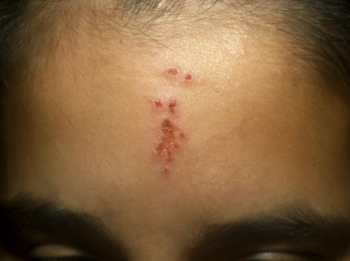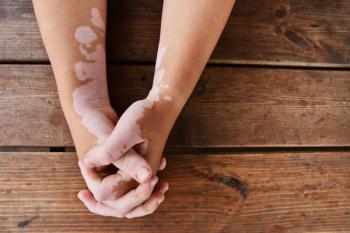
- Consultant for Pediatricians Vol 6 No 6
- Volume 6
- Issue 6
Gianotti-Crosti Syndrome
For about a week, a 4-year-old girl had a nonpruritic rash that initially appeared on her legs and arms. Lesions then spread to her face, hands, and buttocks; the trunk was spared. About 2 weeks earlier, the child had had a viral illness that lasted a few days; since then she had been healthy.
For about a week, a 4-year-old girl had a nonpruritic rash that initially appeared on her legs and arms. Lesions then spread to her face, hands, and buttocks; the trunk was spared. About 2 weeks earlier, the child had had a viral illness that lasted a few days; since then she had been healthy.
These discrete, 2- to 5-mm, erythematous, symmetrically distributed papules are characteristic of Gianotti-Crosti syndrome or papular acrodermatitis of childhood. As in this patient, the rash usually involves the face, buttocks, and extensor surfaces as well as palms and soles, and spares the trunk, scalp, and mucous membranes. This benign, self-limited condition is thought to be a localized type IV hypersensitivity reaction to viral or bacterial antigens within the dermis.
First described as an epidemic exanthema with hepatitis B virus (HBV) infection, Gianotti-Crosti syndrome is currently associated with several infectious agents, including Epstein-Barr virus (EBV), Cytomegalovirus, respiratory syncytial virus, coxsackievirus, group A b-hemolytic streptococci, adenovirus, and mycoplasma, as well as live virus vaccines. The infectious agent varies by geographic region--eg, the syndrome is commonly associated with HBV in Japan and the Mediterranean and with EBV in the United States.
Gianotti-Crosti syndrome affects both sexes with equal frequency. The incidence peaks during early childhood. Children with the syndrome are generally asymptomatic. Hepatosplenomegaly and generalized lymphadenopathy are inconsistent findings. Typically, no laboratory studies are needed unless the child has hepatomegaly or jaundice, in which case one should check liver enzymes and various hepatitis virus serologies.
In most cases, no treatment is required. This patient's rash resolved spontaneously within 2 to 4 weeks. *
Articles in this issue
over 18 years ago
Brown Band on Teenager's Thumb: What Cause?over 18 years ago
Child With "Burns" on the Tongueover 18 years ago
Red-Colored Stoolover 18 years ago
Caterpillar Stingover 18 years ago
Complications of Body Artover 18 years ago
Nummular Eczema and Juvenile Plantar Dermatosisover 18 years ago
Cerebral Palsy: A Multisystem Reviewover 18 years ago
Consultations & Commentsover 18 years ago
Glued to the Tubeover 18 years ago
Trichobezoar in a Young Girl With Abdominal Pain and AlopeciaNewsletter
Access practical, evidence-based guidance to support better care for our youngest patients. Join our email list for the latest clinical updates.











